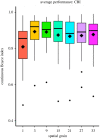The influence of scale-dependent geodiversity on species distribution models in a biodiversity hotspot
- PMID: 38342213
- PMCID: PMC10859231
- DOI: 10.1098/rsta.2023.0057
The influence of scale-dependent geodiversity on species distribution models in a biodiversity hotspot
Abstract
Improving models of species' distributions is essential for conservation, especially in light of global change. Species distribution models (SDMs) often rely on mean environmental conditions, yet species distributions are also a function of environmental heterogeneity and filtering acting at multiple spatial scales. Geodiversity, which we define as the variation of abiotic features and processes of Earth's entire geosphere (inclusive of climate), has potential to improve SDMs and conservation assessments, as they capture multiple abiotic dimensions of species niches, however they have not been sufficiently tested in SDMs. We tested a range of geodiversity variables computed at varying scales using climate and elevation data. We compared predictive performance of MaxEnt SDMs generated using CHELSA bioclimatic variables to those also including geodiversity variables for 31 mammalian species in Colombia. Results show the spatial grain of geodiversity variables affects SDM performance. Some variables consistently exhibited an increasing or decreasing trend in variable importance with spatial grain, showing slight scale-dependence and indicating that some geodiversity variables are more relevant at particular scales for some species. Incorporating geodiversity variables into SDMs, and doing so at the appropriate spatial scales, enhances the ability to model species-environment relationships, thereby contributing to the conservation and management of biodiversity. This article is part of the Theo Murphy meeting issue 'Geodiversity for science and society'.
Keywords: Colombia; geodiversity; mammal conservation; spatial heterogeneity; species distribution models.
Conflict of interest statement
We declare we have no competing interests.
Figures





References
-
- Parks KE, Mulligan M. 2010. On the relationship between a resource based measure of geodiversity and broad scale biodiversity patterns. Biodivers. Conserv. 19, 2751-2766. (10.1007/s10531-010-9876-z) - DOI
-
- Benito-Calvo A, Pérez-González A, Magri O, Meza P. 2009. Assessing regional geodiversity: the Iberian Peninsula. Earth Surf. Process. Landf. 34, 1433-1445. (10.1002/esp.1840) - DOI
-
- Record S et al. 2020. Remote sensing of geodiversity as a link to biodiversity. In Remote sensing of plant biodiversity (eds Cavender-Bares J, Gamon JA, Townsend PA), pp. 225-253. Cham: Springer International Publishing. (10.1007/978-3-030-33157-3_10) - DOI
MeSH terms
LinkOut - more resources
Full Text Sources
Medical

